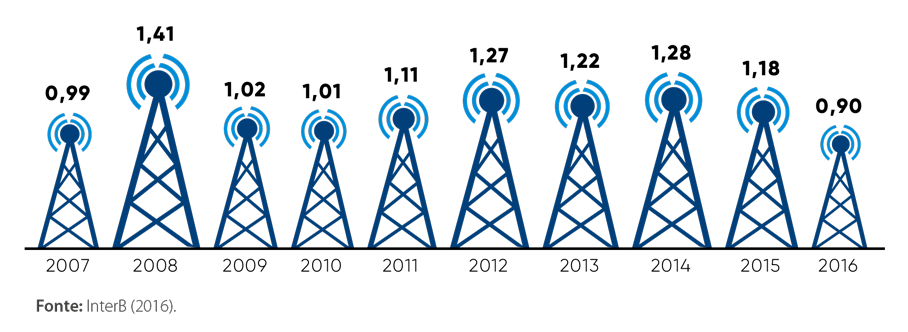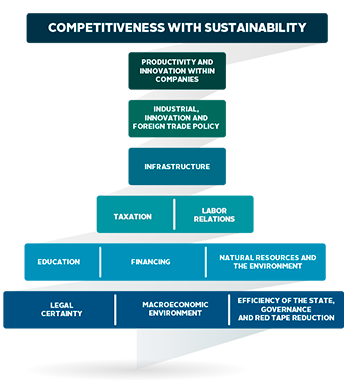Infrastructure
Why Infrastructure?
OCurrent production models are specialized in value chain stages located in different regions. For the Brazilian economy to enter these value chains, investing in energy supply, transportation logistics and telecommunications is necessary.
Efficient transportation logistics makes it possible for inputs to be delivered and final products to be distributed safely and within appropriate deadlines.
Ensuring the access of industry to energy with stable rules, competitive pricing and assured supply is vital for planning investments and competing internationally. Particularly in the natural gas sector, boosting competition and bringing domestic prices closer to international ones are key measures.
The availability of an appropriate framework for high-speed (broadband) data transmission free of oscillations and interruptions and at competitive costs is essential for industrial organization and production processes.
Improving the telecommunications infrastructure is crucial for enabling the development of digital solutions designed to address major challenges facing Brazil in areas such as health care, education, energy efficiency and urban mobility.
VISION FOR 2022
Public and private investments in infrastructure are expanded. The Brazilian logistics system becomes more efficient and integrated, with a better distribution among modes. The share of the railway system in the cargo transportation market was increased, the quality of railroads was improved and the capacity and efficiency of ports were expanded.
Energy is being supplied at competitive prices in relation to other countries. The digitization of the economy was sped up by increasing the coverage and quality of the telecommunications infrastructure, raising the productivity of industry and contributing to improvements in public services in the areas of education, health care and urban mobility.
How are we doing?
Brazil was ranked 17th among 18 countries in the Infrastructure and Logistics factor, according to the report Competitividade Brasil 2017-2018: comparação com países selecionados.
INFRASTRUCTURE RANKING

Note: Mean scores (0 = worst performance; 10 = best performance).
Where do we want to get to?
Main goal: Improving Brazil's infrastructure
Macro objective: Increasing the share of infrastructure investment in GDP from 1.95% to 3%
SHARE OF INFRASTRUCTURE INVESTMENT IN GDP

Source: CNI, based on data from Inter B.
PRIORITY TOPICS
PRIVATIZATIONS AND CONCESSIONS
Increasing private sector participation in investments and service provision is necessary for filling infrastructure gaps
Brazil still has gaps in infrastructure that hinder the country's growth. Efforts must be urgently made to expand and improve the quality of the existing infrastructure. This requires increased public and private investment and greater efficiency in its management.
Given the fiscals constraints faced by the Brazilian state, increasing the share of private investment to ensure the resumption of investments is a must.
Creating a favorable environment is a necessary condition for such investments to occur. Efforts to set clear standards and promote confidence are fundamental for this purpose. This involves strengthening regulatory agencies and improving regulatory frameworks, management structures and sectoral planning.
The country needs to expand its privatization and concession agenda for private investment to materialize and contribute to filling gaps in the country's infrastructure.
INVESTMENT OF PRIVATE COMPANIES IN INFRASTRUCTURE AS A PERCENTAGE OF GDP

Objective
Expanding private sector participation in investments in infrastructure and in its management
 GOAL
GOAL
Increasing the share of private investment in infrastructure in total investment in infrastructure from 53.8% to 60.0%
![]() INICIATIVES
INICIATIVES
- Promoting privatizations or concessions of infrastructure projects
- Improving standards and procedures for privatizations and concessions
- Ensuring the feasibility of new municipal concessions and Public-Private Partnerships (PPPs) on urban infrastructure projects (sanitation, mobility, housing and public lighting)
LOGISTICS AND TRANSPORTATION
Relying on an efficient transportation network capable of interconnecting different logistic modes is necessary
Investing in improving the efficiency of the different modes and in integrating them appropriately along the main logistical axes through which manufactured goods are transported is also necessary.
Therefore, Brazil needs to increase the supply of transportation systems and develop its integration infrastructure by building distribution centers, multimodal integration terminals, and transshipment and storage terminals.
In the railway system, it is necessary to expand the network, increase the speed of trains in circulation and promote better integration between lines.
In the roadway system, it is necessary to invest in lane duplication, adjustments, paving, restoration and conservation of the mesh, besides improving signage and weight and speed control on highways.
In ports, it is necessary to eliminate problems in access by road or sea and to improve the coordination between the authorities involved in port activities to reduce the costs of using ports. It is also necessary to make more cabotage routes available and to increase the capacity of ports and container terminals.
Airports must have runways and facilities suitable for large cargo aircraft. In addition, delays and the costs for clearing air cargo must be reduced.
BRAZIL'S RANKING IN INFRASTRUCTURE COMPONENTS AMONG 137 COUNTRIES

Objectives
Increasing the supply and efficiency of transportation modes
 GOAL
GOAL
Increasing the average speed on railways from 16.4km/h to 18km/h
![]() INICIATIVES
INICIATIVES
- Maintaining free competition in road transportation
- Implementing the right of way for railroads
- Promoting intermodality, considering industry's supply and distribution chains
Reducing the logistics costs of foreign trade
 GOAL
GOAL
Increasing container handling capacity per hour from 43.6 to 80.0
![]() INICIATIVES
INICIATIVES
- Reducing rates, charges and tariffs on cargo transportation
- Reducing red tape in public ports
- Adjusting the maritime, terrestrial and operational infrastructure of ports considering trends in merchant navy
- Following up on the process of defending competition in container transportation and on procedures of foreign shipowners involved in transporting internationally traded Brazilian products
ENERGY
Competitiveness gains for industry depend on the availability of energy with internationally competitive quality and prices
Industry is the largest consumer of electricity in Brazil. The industrial sector is the most impacted by the prices above world average charged in the domestic market and by the poor quality of energy supply services.
According to CNI (2016d), power supply failures cause significant losses to 67% of Brazilian industrial companies, which mainly use electricity in their production process.
Stimulating the use of other energy sources, particularly natural gas, is necessary. Used in industrial processes as a source of thermal energy, natural gas is an energy source that is less aggressive to the environment. Despite its importance, natural gas supply in Brazil is marked by large regional disparities and high costs as compared to other countries.
RANKING OF THE QUALITY OF ENERGY SUPPLY

Objectives
Ensuring electricity supply with improved quality and at lower costs
 GOAL
GOAL
Keeping the cost of electricity below R$319.00 (in reals in 2006 per MW/h)
![]() INICIATIVAS
INICIATIVAS
- Implementing measures to ensure quality energy supply at competitive prices
- Reducing electricity costs for industrial consumers
Increasing the supply of natural gas and reducing its cost to international competitive levels
 META
META
Reducing the difference between the price of natural gas in Brazil and the average price as measured by the Henry Hub index from 484% to 200%
![]() INICIATIVES
INICIATIVES
- Improving the regulation of the natural gas industry
- Approving a national policy for land-based gas exploitation
TELECOMMUNICATIONS
The provision of high-performance and low-cost broadband connectivity is a fundamental condition for implementing the Internet of Things and Industry 4.0 in Brazil
Brazil needs to improve the provision of broadband services to make progress in digitizing industrial production. A good telecommunications network is essential for Brazilian companies to take advantage of opportunities to reduce production costs through digitization, develop new business models, specialize themselves and take part in local and global value chains.
Technologies associated with the Internet of Things can in turn offer solutions to some of the main national problems faced in the areas of health care, urban mobility and energy efficiency.
Broadband services in Brazil are expensive and slow and they are often slower than contracted.
In addition, Brazil ranks second in the world in tax burden on telecommunication services (more than twice that of the third-placed country).
The average internet speed in Brazil leaves much to be desired. In the ranking of the State of Internet Report 2017 (Akamai, 2017), which includes 148 countries, Brazil was ranked 79th. The average connection speed in Brazil is 6.8 Mbps, slower than in the large majority of countries in North America and Europe. In South America, it is behind Chile and Uruguay.
Objective
Expanding the access to faster and lower-cost broadband services
 GOAL
GOAL
Increasing the percentage of Brazilian households with fixed broadband access from 38.5% to 55.0%
![]() INICIATIVES
INICIATIVES
- Improving the legal framework for telecommunications
- Eliminating bottlenecks in telecommunications infrastructure with a view to developing Industry 4.0 and improving public services
- Expanding the supply and improving the quality of telecommunications infrastructure
KEY FACTORS
Click on each key factor below to learn more about the Map






